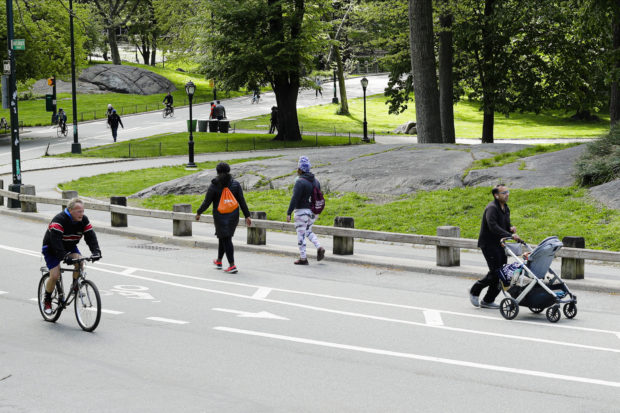ALBANY, N.Y. — New York nursing homes must start twice-weekly coronavirus testing for all staffers and will no longer be sent COVID-19 patients leaving hospitals, Gov. Andrew Cuomo announced Sunday after facing criticism over the handling of nursing facility outbreaks. New York City is responding to complaints about racial disparities in enforcement of social distancing by ramping up a corps of city workers to try to keep people in line without involving police.

Bicyclists and runners enjoy Central Park, Saturday, May 9, 2020, in New York during the coronavirus pandemic. (AP Photo/Frank Franklin II)
Here are the latest coronavirus developments in New York:
NEW RULES FOR NURSING HOMES
The new testing requirements and ban on hospitals sending coronavirus patients to nursing homes came a day after an AP report in which residents’ relatives, nursing home watchdogs and politicians from both parties criticized the Cuomo administration’s policies on both.
They second-guessed a state directive as requiring nursing homes to take on new residents infected with COVID-19 — an order that critics said accelerated outbreaks in facilities that are prime breeding grounds for infectious diseases.
Of the nation’s more than 26,600 coronavirus deaths in nursing homes and long-term care facilities, a fifth of them — over 5,350 — are in New York, according to a count by The Associated Press.
That’s the highest number of nursing home deaths in the country, though other states have also struggled to control the virus in nursing facilities. Indeed, they account for a higher percentage of coronavirus deaths in most other states, Cuomo said.
Critics have faulted New York for taking weeks to release the number of deaths in individual homes, for still not releasing the number of cases and for not conducting or requiring widespread testing in the facilities.
Now, workers will be tested twice a week, Cuomo said at a news briefing. Residents are being tested as much as possible, he said.
A March 25 state health department directive said nursing homes couldn’t refuse new or returning residents because they tested positive for the virus. The policy, similar to one in neighboring New Jersey, was intended to help free up hospital beds for the sickest patients as cases surged.
Now, “we’re just not going to send a person who is positive to a nursing home after a hospital visit,” Cuomo said Sunday. He said such patients would be accommodated elsewhere, such as sites originally set up as temporary hospitals.
The new policy still allows nursing homes to take some people with COVID-19, such as those who are at home and need care. But hospitals are responsible for finding alternatives for the patients they discharge, and nursing facilities shouldn’t take on coronavirus patients if unable to care for them, Cuomo said.
The Democrat also emphasized that nursing homes should transfer any person they can’t care for.
For most people, the new coronavirus causes mild or moderate symptoms. For some, especially older adults and people with existing health problems, it can cause more severe illness and lead to death.
SOCIAL DISTANCING “AMBASSADORS”
After an outcry over racial disparities in New York City’s enforcement of social distancing, the mayor planned Sunday to double the ranks of non-police workers trying to persuade people to comply with the policy.
The number of city workers deployed as “social distancing ambassadors” will grow by next weekend from around 1,000 to 2,300, Mayor Bill de Blasio said in an online media briefing.
“More and more, the emphasis will be on a communicative, encouraging approach,” the Democrat said, while noting that enforcement through ticketing “will still be there when needed.”
The city didn’t immediately have information on social distancing arrests or summonses, if any, over the weekend. De Blasio reiterated there have been relatively few — under 10 summonses a day citywide — but that enforcement needs to be done “fairly and consistently in all communities.”
Criticism has arisen along with videos of violent arrests — including scenes of a police officer running at a black man and throwing him to the ground for mouthing off and an officer punching a man in the head as he lay pinned to a sidewalk — and statistics on the racial breakdown of police action taken in the name of curbing the spread of the COVID-19 virus.
New York City police department data released Friday showed that of the 374 summonses issued through May 5 for violating distancing orders, 52% were given to black people and 30% to Hispanic people.
The mayor on Friday said those statistics show “something’s wrong.” He pledged more training and clearer protocols for officers.
Citing such numbers, police reform advocates have pressed the city to stop using police to enforce rules that require people to wear masks and stay 6 feet (2 meters) apart from anyone who doesn’t live in their own household.
De Blasio said Friday that police officers would start limiting access to three New York City parks where passers-by have captured — and shared — images of predominantly white, young people gathering without masks.
The city’s social distancing enforcement has also brought complaints from some Hasidic Jews after police broke up large public funerals in Brooklyn.
And civil rights advocates raised questions after police issued at least one social distancing summons at a small protest organized by an LGBT group outside a Manhattan hospital last weekend.
A VIRTUAL MOTHER’S DAY
Like many Americans, Cuomo didn’t get together with his mom on Mother’s Day because of social distancing. But he got to see her by video, as did anyone watching his news briefing.
“I wish I could be with you,” Cuomo told his mother as reporters looked on and his three daughters variously joined in from the briefing room and via video. But “I can’t be with you because I love you.”
Matilda Cuomo told her eldest son she missed him, too — and “I will never forget this.”